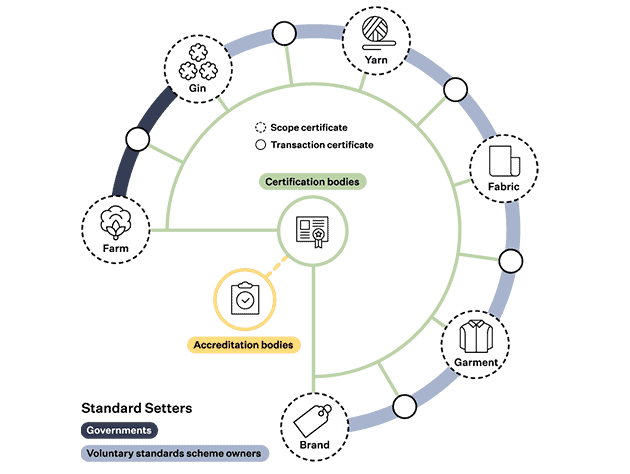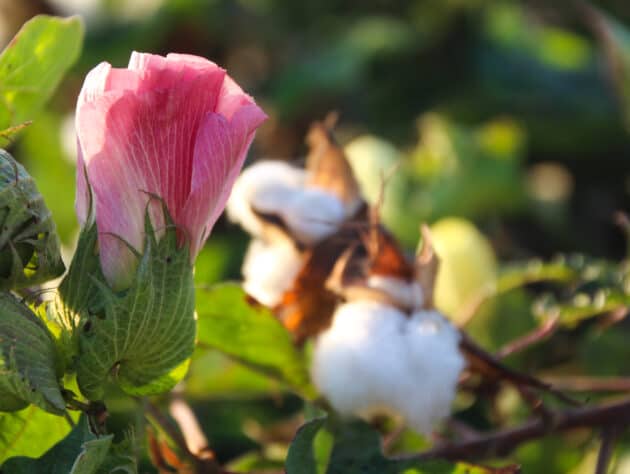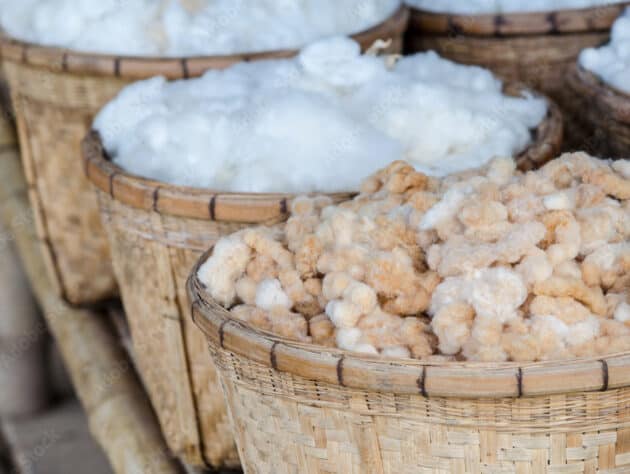How organic cotton certification works
The term “organic” is legally controlled. That means that a farm must be certified to its relevant government-controlled organic standard to sell its cotton as organic, ensuring these agricultural practices are respected on the ground.
Once the cotton leaves the farm, it isn’t covered by the same legal protections.However, a company might choose to use a tool like Textile Exchange’s Organic Content Standard (OCS) or the Global Organic Textile Standard (GOTS) to keep track of these fibers as they move from the gin through to the final product.
In a notoriously complex supply chain, the purpose of the OCS is to help strengthen companies’ claims that the products they sell contain organically grown fibers. It does this by managing the chain of custody and reconciling volumes of organic materials as they move along the supply chain.
ABOUT
Who’s involved in organic cotton certification?
Governments
To be legally sold as organic, raw cotton must be grown on a farm that is certified to its respective government-controlled organic standard.
Voluntary standards scheme owners
Voluntary standards such as the OCS or GOTS use a chain of custody model to track volumes of organically grown cotton as they move along the supply chain.
Certification bodies
Neither the governments that set national organic standards, nor voluntary standard-setting organizations like Textile Exchange and GOTS, carry out on-the-ground certification themselves. This is the role of certification bodies.The certification bodies that check farms, and those that check other facilities in the supply chain, may also be different, and they check for different things according to the standards.
Accreditation bodies
Accreditation bodies monitor and assess the certification bodies to ensure that they are operating as intended. This process allows standard-setting bodies to detect irregularities, delivering confidence to consumers.
The CBs that check farms and COC may also be different and they also check for different things according to the standards.

CHALLENGES
Protecting the integrity of organic cotton
While voluntary standards like ours have helped to manage the chain of custody, it’s still incredibly tricky to trace organic cotton from farm to final product.
Often, fraud occurs most often where financial pressure, opportunity, and the potential for rationalization meet. In the case of cotton, this could be a result of underinvestment, the presence of loopholes, and the perception among supply chain partners that their efforts or the risks they’re taking are not being rewarded fairly.

WHAT WE’RE DOING
Finding and reinforcing the fault lines
One of the key reasons it is difficult to achieve full traceability in organic cotton supply chains is due to the fragmentation of roles, responsibilities, and data in the certification schemes used for the farm and the rest of the supply chain. Accountability sits across governments, voluntary standard owners (like us), certification bodies, and other stakeholders. Here are some of the fault lines we’ve identified, and the actions we are taking to reinforce them.
Between farms and gins
While national organic standards certify the farm, voluntary supply chain standards like the OCS start with the certification of the gin. Switching between standards at this stage can make it harder to deliver farm-level traceability to brands, but re-auditing the farms as part of the OCS would put extra work and costs on producers. Instead, we have to rely on accurate information coming to us. That’s why, together with GOTS, Textile Exchange has committed to collecting farm-level data from gins and working collaboratively with GOTS to reconcile farm-to-gin volumes.
Between facilities
Managing the chain of custody of organically grown cotton as it moves between different facilities in the supply chain relies on a trail of physical and pdf certificates. Evidence suggests that these facilities are continuously finding ways to substitute certified organic fibers. To identify and prevent this kind of fraud, we’re doing everything we can to guide certification bodies as to what to look for, helping them detect it. This includes regularly improving our auditing requirements, as well as instigating or requesting investigations where reports of fraud have been alleged.
Between certification bodies
While Textile Exchange manages the OCS standard requirements, on-the-ground certification is implemented by 20 different certification bodies. While having certification data spread across different certification bodies has long made full traceability tricky, our newly launched Trackit program centralizes and digitizes this data for volume reconciliation, providing increased supply chain visibility. Having access to this data will allow certification bodies to see the complete picture and help them to detect any anomalies as cotton moves from one responsible certification body to another. As part of our assurance process, we are also increasing oversight of certification bodies’ activities by conducting and increasing the number of shadow audits and banning certification bodies or traders that are engaged in fraudulent activities.
Between OCS and GOTS
Allowing content certified to GOTS to be accepted into OCS products has helped to keep costs down for suppliers in the past. However, it has also meant that chain of custody data has been fragmented between the two organizations. For this reason, as of December 1, 2022, Textile Exchange’s OCS has ceased accepting GOTS inputs from sites unless we receive all GOTS transaction certificate data that provides traceability back to the original farm source. Additionally, all first processors (e.g. cotton gins) that provide GOTS inputs into an OCS product down the supply chain must now also be certified to the OCS. This means that we’ll always have access to information about the original certified farms, and the organic inputs they provide.
Next Steps
Building a more robust model
Putting restrictions in place and reviewing them frequently might be one way to help to prevent fraud. But it is essential to get to the root cause of the problem, not just manage the symptoms. This means helping others through education, to recognize it, address it, and remediate the challenges that cause it to happen in the first place – dedicating resources to this purpose.
To fight fraud effectively and build a robust system of integrity, organizations need to go beyond building compliance through standards and certification towards achieving traceability for organic content, improving incentives for supply chain partners, and collaborating with others.
Textile Exchange’s Organic Cotton Market Report is a key tool that helps us to do this by aggregating global and regional data on organic cotton production. Having a framework that pulls these numbers together helps the industry work out what is happening on the ground, understand when things don’t add up, pinpoint with greater accuracy when and where there are mistakes or inconsistencies, and address the reasons behind them.

Learn More
Read our report on integrity
Our Climate+ strategy gives companies across the fashion and textile industry a common goal. We’re taking an interdisciplinary, interconnected approach that does away with blanket solutions in favor of tailored, targeted strategies for independent impact areas: climate, water, soil health, and biodiversity.
In our 2022 report, “Strengthening Integrity in Organic Cotton” we focus on practical guidance that our members can use to confront a major sector challenge and protect trust in organic–a vital way of tackling the climate crisis.